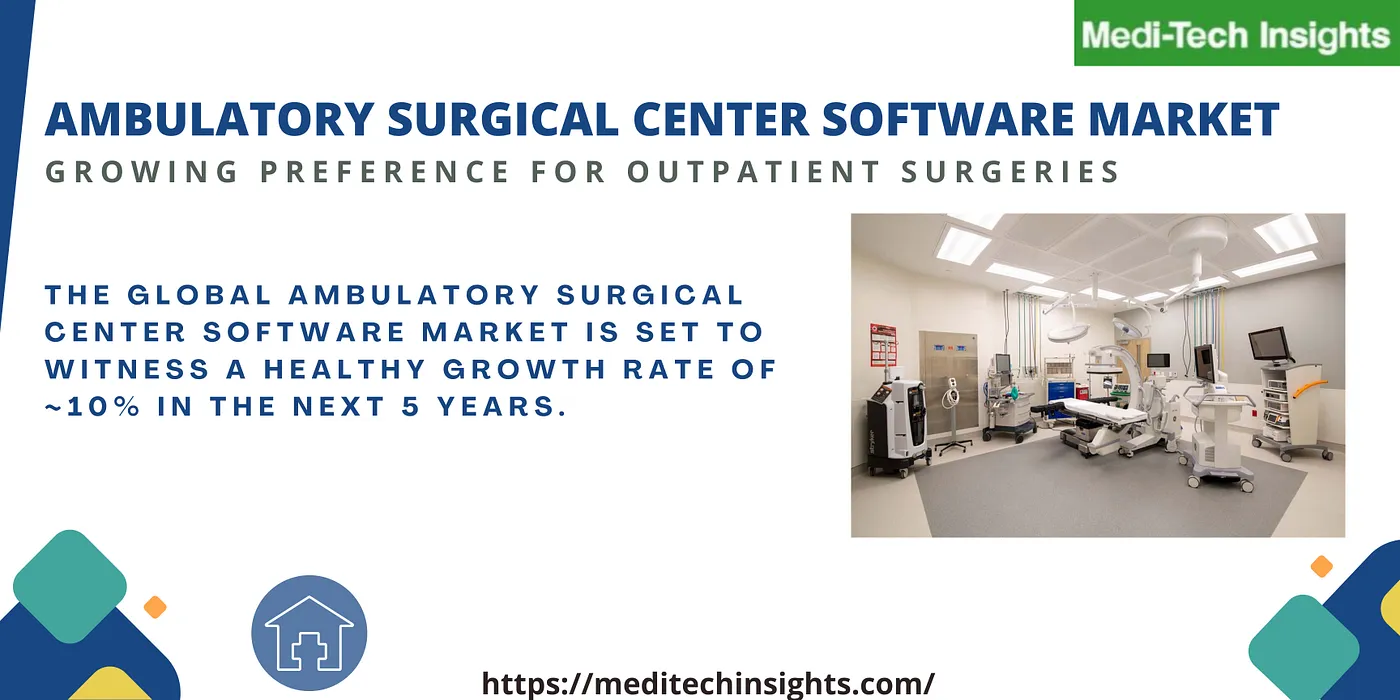Ambulatory Surgical Center software market is poised to witness a growth rate of ~10% in the coming 5 years. A need to limit the rising healthcare cost; Growing trend of performing surgical procedures in ambulatory settings and resulting growth in the number of procedures at ASCs; increasing physician and patient preference for outpatient surgeries; and launch of advanced solutions for ASCs are some of the key factors driving growth in the ambulatory surgical center software market.
Ambulatory care is a medical care provided in outpatient setting and does not require hospital admission. Ambulatory Surgical Center or ASCs — are health care facilities specialized in providing same-day surgical care, including diagnostic and preventive procedures. ASCs have transformed the outpatient experience by providing a more convenient alternative to hospital-based outpatient procedures. Common procedures performed in ASCs include cataract surgery, gallbladder removal, tonsillectomy, endoscopy/colonoscopy, arthroscopic/orthopedic procedures, and cardiac procedures. Because of their cost benefits and convenience the volume of procedures performed at ASCs is Increasing and software are likely to play a crucial role in these settings by easing day to day operations by effectively preparing staff and patients for pre-op and post-op tasks.
To know more about the research report, fill out a quick inquiry for a sample report: https://meditechinsights.com/ambulatory-surgical-center-software-market/request-sample/
The Increasing investment in ASC space from healthcare companies/PEs indicates the high growth potential in the Ambulatory Surgical Center Software Market
Investment firms have recognized the increasing popularity of undergoing surgeries in non-hospital environments, as well as the importance of Ambulatory Surgery Centers (ASCs) in facilitating these procedures. Drawn by the lucrative growth potential in the space, many investors have backed independent ASCs and have consolidated to form larger groups/chains. United Surgical Partners International (USPI), AmSurg, HCA, and Surgical Care Affiliates (now SCA Health) are some of the examples of large ASC chains operating in the U.S. Number of ASCs operated by USPI have increased from ~250 in 2015 to more than 465 at present. Similarly, number of facilities operated by Surgical Care Affiliates increased from about 185 in 2015 to more than 320.
Key players are focusing on development of new features/solutions for ASCs
Key players in the Ambulatory Surgical Center Software Market are constantly concentrating on developing new software solutions or adding new features to existing ASC solutions. Some of the related developments are listed below-
· In January 2023, Ospitek launched live patient charting for ambulatory surgery centres (ASCs) as part of the company’s latest update to the proprietary surgical coordination platform “VIEW”
· In November 2022, 3M Health Information Systems (HIS) announced the launch of 3M Ambulatory Potentially Preventable Complications (3M AM-PPCs) software, developed to ensure patient safety and quality oversight for procedures performed at ASCs/hospital outpatient departments
· In October 2022, EClincalWorks launched EHR software, V12. The new version has features such as 40% faster speeds, improved usability with redesigned screens, a module for pre visit planning, Improved procedure documentation, and enhancements to the ASC workflow model, among others
ASCs are not federally mandated to implement EHRs — a barrier to the adoption of ASC solutions in the U.S can Hamper the Ambulatory Surgical Center Software Market
Since 2008, EHR adoption in office-based settings has been increasing by over 100% from ~40% to more than 80%. However, according to the Ambulatory Surgery Center Association (ASCA), the adoption rate of EHRs in ASC settings remains low (approx. only 20%). Larger adoption rate in non-ASC settings is due to the Health Information Technology for Economic and Clinical Health (HITECH) Act (2009). This act authorized financial incentives of billions of dollars for doctors and hospitals for EHR implementation and Imposed a reimbursement penalty for those providers not using a certified EHR. But, it is not compulsory for ASCs to implement EHRs which has caused their low adoption in these settings. However, low adoption rate also indicates that there is an ample scope for ASC solution providers to penetrate the Ambulatory Surgical Center Software market.
North America Holds a Major share in the ambulatory surgical center software market
From a geographical outlook, North America holds a large market share of the ambulatory surgical center software market. This is mainly attributed to the presence of large number of ASC centers and number of procedures being performed, relatively greater adoption of ASC solutions, rising financial incentives, and high prevalence of various diseases and associated surgeries. The number of Medicare certified ASCs have shown consistent growth in the U.S. from ~5200 in 2011 to ~5500 in 2015 and ~5800 in 2020 (total number of ASCs in the U.S. is ~11,800). In the past, procedures performed at ASCs were reimbursed based on the Consumer Price Index for All Urban Consumers (“CPI-U”), which resulted in lower reimbursement rates for these procedures.However, from 2019 through 2023, CMS decided to update the ASC payment system using the hospital market basket update, rather than the CPI-U. This further improved reimbursement for ASC procedures. Such developments are likely to drive ASC and in turn, ASC software market growth.
Competetive landscape of the Ambulatory Surgical Center software market
Some of the key players in Ambulatory Surgical Center software market includes athenahealth, Cerner, Epic, Allscripts, Surgical Information Systems (SIS), HST Pathways, EClincalWorks, Nextgen Healthcare, and Advanced Data Systems Corporation, among others.
Get Detailed Insights on the Ambulatory Surgical Center software market @ https://meditechinsights.com/ambulatory-surgical-center-software-market/


